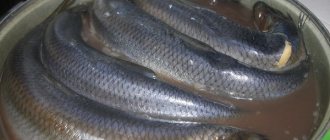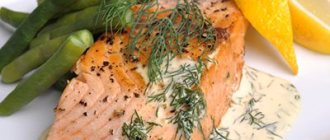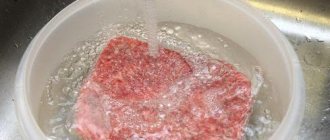After fishing, in every house you can see a bunch of scales scattered throughout the kitchen and the dissatisfied face of the owner. But this only happens if she knows how to clean fish, and her husband knows how to fish correctly.
But you can learn to do it quickly and correctly in order to minimize the number of scales scattered throughout the kitchen and the housewife’s flour. First you need to choose the right tool to properly clean the fish.
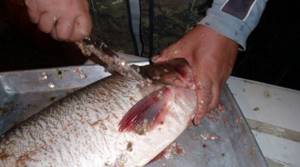
Tool
A kitchen knife is a familiar and traditional tool that all housewives are used to cleaning fish. For safety reasons, if you have never cleaned scales or have not yet gained experience in this difficult task, then it is better to clean with the blunt side of a knife.
Those who are especially timid are advised to use a fork or spoon to avoid injury.
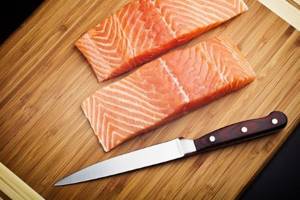
There are also special tools, somewhat similar in design to scrapers. These tools are safe and easy to use. Sometimes you have to clean fish with hard scales (for example, perch, ruffe and the like), in such cases it is recommended to use special graters.
Such instruments are often made independently: simply by nailing several beer caps to a small board (with the reverse side).
An empty tin can also makes a great grater. You just need to fill the holes on the inside of the jar, so that a kind of grater, sharp bulges, are formed at the bottom of the jar.
Preparatory work
The first step is to thoroughly wash the fish in cold water. If you decide to clean the fish some time after washing, you need to wet it again - wet scales are much easier to clean.
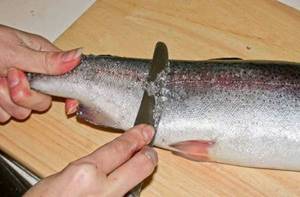
If you happen to clean hard scales or they are very close to the skin, so that it is quite difficult to clean them, just dip the fish in boiling water for a few seconds. This is a very important process in which it is important not to overcook the fish.
Very often housewives risk injuring their finger on the fins of a fish. This can be easily avoided - simply cut off the fins with scissors or cut them out with a sharp knife. This will greatly simplify the cleaning process and protect your fingers from damage.
How to remove offal
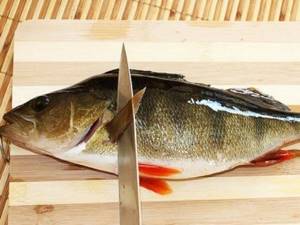
The process of removing giblets from fish frightens many, although there is nothing scary about it. Everything is quite simple and fast, the main thing is to follow the well-known recommendations and tips:
- You need to clean the fish and remove the giblets on the same day, or better yet, at the same time.
- You will definitely need a cutting board. In order not to contaminate the board, you can put a bag on it or put a piece of paper on top.
- The cut is made in the direction from the head to the tail, while you need to hold the fish with its belly down.
- The contents are easily removed using a knife or spoon.
- The black film on the walls of the belly also needs to be cleaned.
- Now all that remains is to rinse the fish and its belly under running water.
How to properly gut fish
For gutting, you will need a kitchen knife and a cutting board. If the board is wooden, the smell will not be washed off at once, so we recommend covering the board with newspaper or a regular bag. This technique will allow you to get rid of the fishy smell immediately after gutting the carcass and quickly clean the work area. By the way, this advice is also relevant for plastic boards.
Place the carcass on the board with the ridge down and the belly up. Using a kitchen knife or scissors, we cut the belly almost from the head to the anus (located near the tail), so that it is convenient to get “all the contents” and clean it out with a knife, while trying not to touch the gall bladder. In addition to the intestines, do not forget to remove the red-brown film located on the walls of the belly.
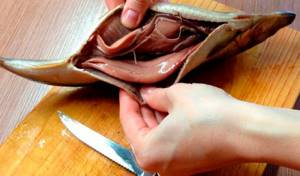
Gutting process
Let's move on to the head. If you decide to leave it, you need to remove the gills so that the future dish does not become bitter. If the head is too small or simply not needed, cut it off and don’t suffer. After this, rinse the fish thoroughly again and you can start creating delicious things.
As you can see, the process is not difficult, but after it you will be filled with a feeling of pride that you were able to cope on your own. Having done this at least once from start to finish, you can tell your friends how to properly clean fish from scales.
If you don’t know how to cook this yet, check out the recipes on our website. You can, for example, cook fish in batter, or if you cleaned crucian carp, grease it with sour cream, salt and pepper and put it in the oven, preheated to 180 degrees for half an hour - it will be delicious.
Serve like in a restaurant
You can prepare many dishes from fish, and not just fish soup and frying. Fish pies, jellied meats, and appetizers require housewives to prepare the fish more thoroughly than removing scales and gutting. The above method is suitable for home use when you cook fish for yourself. But if you have to set a festive table, the fish requires a completely different preparation. You need to courageously go through such steps as removing scales, removing fins, gutting, skinning, and filleting.
What to do with frozen fish
Cutting frozen fish begins with thawing. To prevent it from drying out, it is recommended to thaw it by wrapping the carcass in paper or leaving it in a bag. But the best option is to place the fish in slightly salted water.
If you bought fillet, you can fry it without defrosting, which will preserve its juiciness, or defrost it in air and, if necessary, remove scales.
Cutting off the fins
Often when cleaning fish it becomes necessary to remove the fins. If the fish is large, you can “put them on the fish soup” together with the gutted head.
The first step is to cut off the sharp fins, this is done so that the cooked fish looks appetizing, is beautifully decorated, and is easily cut into portions.
Large sharp fins can be removed with special kitchen scissors even before the process of removing the scales, then the work will be safer. If there is no particular need to remove the fins, you can omit this point. For example, if a recipe calls for boiling fish whole, it is easier to remove the fins after cooking.
How to fillet raw fish
To make fillets, you need to remove the fins along with the bones that attach them to the body. To do this, the tip of the knife is inserted into the bone connective tissue located under the fin. By moving the knife like a lever, it is easy to remove the fin along with the bone.
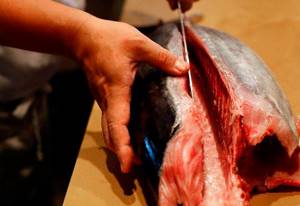
Making fillets from large fish
If you separate the gills, make a cut behind them and pull, you can remove all the insides in one fell swoop without destroying the carcass.
Skin removal
The skin of the fish does not need to be removed if you are going to boil it whole, fry or stew it. Large flat fish can be boiled first, and only then the skin can be easily removed. But some types of fish, due to their recipe or individual characteristics, require removing the skin immediately before cooking. For example, working with sole is as easy as shelling pears: cut and remove.
It is often necessary to remove the skin also because some representatives of the marine kingdom have an unpleasant odor. Sometimes it is easier to fillet the fish first and only then remove the skin - it all depends on the chosen individual.
How to get rid of scales
To save yourself from the painful process of getting rid of fish scales, you just need to forever remember how to properly clean fish and perform all actions in a certain sequence and following some recommendations:
- If you have recently taken fish out of the freezer, you need to rinse it with water, otherwise it will be slippery. You can additionally sprinkle your hands with salt, this will help hold the fish in your hands. If you still feel uncomfortable, hold the fish with a towel.
- You need to choose a basin or pan in which the whole cleaned fish will fit. If you are very afraid of polluting the kitchen, then you can clean the fish under running water or inside a thick plastic bag.
- If the fish scales are dry, then you need to slightly moisten them and wait until they swell.
- Now you need to cut off the head and fins of the fish (to avoid injury).
- The scales can be removed with different objects, depending on what is more convenient for you: a spoon, fork, knife or a special grater.
- You need to clean the fish against the growth of the scales (in the direction from the tail to the head). It is most effective to make sharp and short movements with your hand. Clean the sides first, then move on to the belly.
- Now all that remains is to rinse the fish and get rid of stuck scales and evaluate the quality of cleaning the fish.
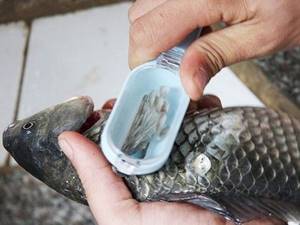
If you are going to salt fish or smoke it, then it is not necessary to clean the scales. This will preserve the maximum amount of natural substances. If you go to a store or market to buy fish, you can buy already cleaned fish there without any problems.
How to properly clean fish from scales
Cleaning of fish is carried out not only outside, but also inside. To avoid swallowing a bone, which, as everyone knows, is quite sharp and can subsequently cause significant discomfort, you need to be able to clean it correctly.
Often, it is ignorance of the matter that can lead to the fact that for several days after cleaning the fish you will find rare scales in the nooks and crannies of your kitchen. Therefore, to avoid this, if this is your first time doing this, take the advice of experienced fishermen or look at some materials that will make the process easier.
How to scale fish quickly
The basic rule for cleaning fish from scales is the direction in which the process should move. They begin to clean from the tail towards the head, against the growth of the scales. Before this, you need to cut off the fins. To do this, use a sharp knife or special kitchen scissors. To prevent scales from flying in all directions, you can use several tips.
We recommend reading:
What's better to sleep in a tent at night?
For example, cleaning fish in water. It will prevent the formation of scaly coating on the floor. Or you can first pour boiling water over the fish and then cool it sharply. After this, the scales will come off easier. Another way to quickly clean fish from scales is to freeze it tightly, and then put it to defrost for a short time, exactly until the outer covers thaw a little. This will make it easier to remove the skin along with the scales.
You can use not a knife, but a special grater with sharp teeth. It is quite possible to make it yourself and even in the field. For example, make holes in the bottom of a tin can with torn edges.
Sticky scales will accumulate on the grater and thereby minimize the process of environmental pollution.
How to debone fish
To debone fish, you first need a sharp knife. After carrying out the initial manipulations with it, such as peeling and gutting, you can begin to extract the skeleton. To do this, place the fish on a cutting board and press it as hard as possible with your hand. First remove the head and fins.
After you have attached it, use a knife to pick up the ridge in the area of the head and gently begin to pull it, moving towards the tail. The slower the process, the more small seeds you can pull out.
You won't be able to remove all the bones this way. To finish what you started, use small tweezers or tweezers. Well, or use your nails if you have long ones and you are not afraid of the fishy odor from your hands later. This way you can remove all the bones and you will have a great fillet that you can cook however you like.
Cleaning by fish type
The structural features of the fish and the growth of its scales greatly influence the choice of the method of proper and quick cleaning. As an example, consider flounder or mackerel, which are completely devoid of scales. But catfish and burbot have it, although it is very small. But perch and ruffe are generally distinguished by strong scales, and if you don’t know how to clean fish with similar features, then this will really be a difficult process.

Perch
Everyone does not like to clean this fish. Very tough scales are usually difficult to process, so most people prefer to peel the skin along with the scales. This greatly simplifies the cleaning process.
Zander
The dorsal fin of this predator deserves special attention - it is really very sharp. All you need to do is cut off the fin using scissors or a sharp knife. After this, the process of cleaning pike perch is no different from other fish.
Horse mackerel
Horse mackerel also keeps up with perch and pike perch; its scales are no softer than those of other representatives of the fish world. To make the cleaning process easier, simply dip the fish in boiling water. Then the scales will steam and the process of cleaning the fish will be much easier.
Catfish
Catfish is a little more difficult to clean than other fish. First you need to carefully gut the fish, cut off the fins and remove the head. The next step is to fillet the fish. After this, all that remains is to remove the skin from it.
Burbot, eel
Everything here is extremely simple - make a shallow cut around the head of the fish and remove the skin. This process is quite simple, so it does not require any special skills. Burbot liver is a very valuable product, so many people prepare it separately.
Tench
Small and dense scales, and even covered with mucus, greatly complicate the cleaning process, so rarely can anyone cope with it the first time. But this is because many people don’t know the basic trick - you need to put the fish in boiling water, and then quickly transfer it to cold water.

Som
The first step is to clean the skin of the river giant from mucus, cut off the fins and remove the offal. Then the skin is simply removed. When cleaning large specimens, it is recommended to cut them into small pieces to make cleaning easier.
Oven baking recipe
Haddock is a tasty, non-greasy and healthy fish. If you don't know how to cook haddock fish in the oven, remember the recipe.
Ingredients:
- haddock steaks (quantity based on number of persons);
- three garlic cloves;
- Bay leaf,
- white and dark peppercorns;
- three tablespoons of soy seasoning;
- two tablespoons of mayonnaise and ketchup.
Cooking method:
- First of all, the fish steaks need to be marinated. To do this, mix soy seasoning with chopped garlic and place fish pieces in the prepared marinade for 20 minutes.
- Pour some water and oil into the mold, add a bay leaf and lay out the pickled haddock. Sprinkle it with freshly ground pepper flakes and place in the oven for 30 minutes.
- Ten minutes before cooking, pour the fish with ketchup and mayonnaise sauce.
